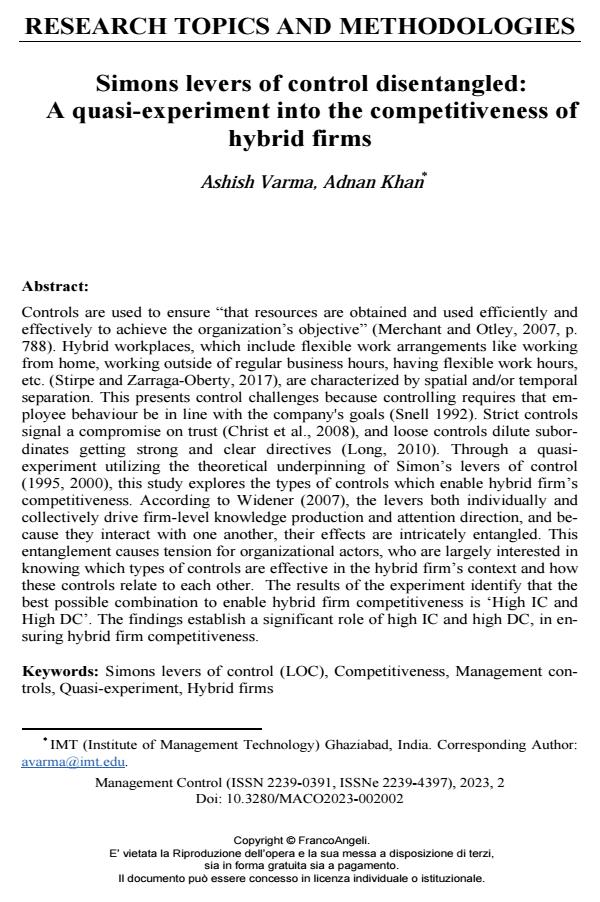Simons levers of control disentangled: A quasi-experiment into the competitiveness of hybrid firms
Journal title MANAGEMENT CONTROL
Author/s Ashish Varma, Adnan Khan
Publishing Year 2023 Issue 2023/2
Language English Pages 23 P. 19-41 File size 311 KB
DOI 10.3280/MACO2023-002002
DOI is like a bar code for intellectual property: to have more infomation
click here
Below, you can see the article first page
If you want to buy this article in PDF format, you can do it, following the instructions to buy download credits

FrancoAngeli is member of Publishers International Linking Association, Inc (PILA), a not-for-profit association which run the CrossRef service enabling links to and from online scholarly content.
Controls are used to ensure “that resources are obtained and used efficiently and effectively to achieve the organization’s objective” (Merchant and Otley, 2007, p. 788). Hybrid workplaces, which include flexible work arrangements like working from home, working outside of regular business hours, having flexible work hours, etc. (Stirpe and Zarraga-Oberty, 2017), are characterized by spatial and/or tem-poral separation. This presents control challenges because controlling requires that employee behaviour be in line with the company's goals (Snell 1992). Strict con-trols signal a compromise on trust (Christ et al., 2008), and loose controls dilute subordinates getting strong and clear directives (Long, 2010). Through a quasi-experiment utilizing the theoretical underpinning of Simon’s levers of control (1995, 2000), this study explores the types of controls which enable hybrid firm’s competitiveness. According to Widener (2007), the levers both individually and collectively drive firm-level knowledge production and attention direction, and be-cause they interact with one another, their effects are intricately entangled. This entanglement causes tension for organizational actors, who are largely interested in knowing which types of controls are effective in the hybrid firm’s context and how these controls relate to each other. The results of the experiment identify that the best possible combination to enable hybrid firm competitiveness is ‘High IC and High DC’. The findings establish a significant role of high IC and high DC, in ensuring hybrid firm competitiveness.
Keywords: Simons levers of control (LOC), Competitiveness, Management con-trols, Quasi-experiment, Hybrid firms
- Assessing the Impact of Accounting Analytic Capabilities on Firm Performance Ashish Varma, Anuj Sharma, in Journal of Computer Information Systems /2025 pp.738
DOI: 10.1080/08874417.2024.2329137 - Accounting-Analytic Capabilities’ Impact on Management Controls and Performance Ashish Varma, Anuj Sharma, Adnan Khan, in Journal of Computer Information Systems /2025 pp.1
DOI: 10.1080/08874417.2024.2441770
Ashish Varma, Adnan Khan, Simons levers of control disentangled: A quasi-experiment into the competitiveness of hybrid firms in "MANAGEMENT CONTROL" 2/2023, pp 19-41, DOI: 10.3280/MACO2023-002002